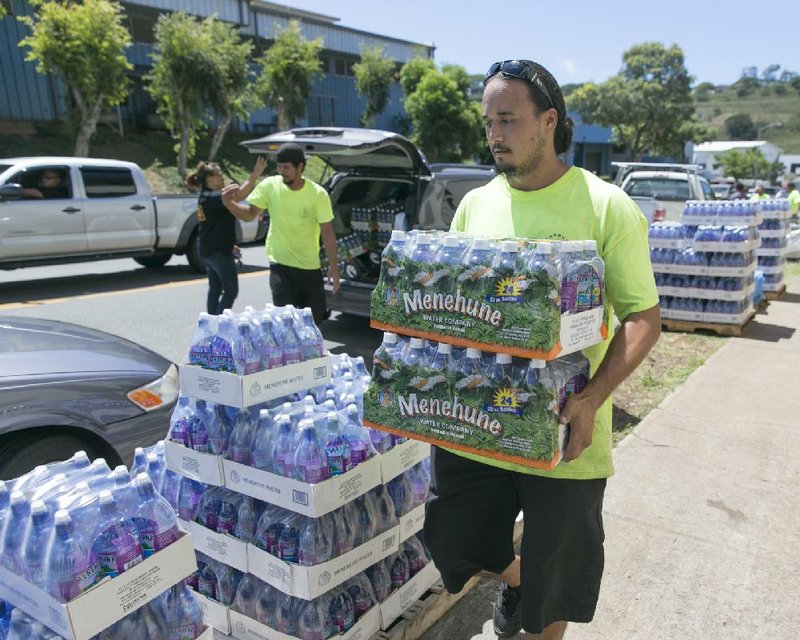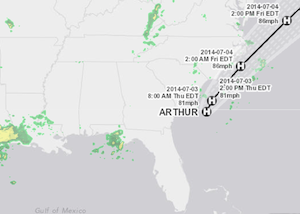HONOLULU -- Barely holding on to hurricane strength, Iselle's outer edges brought rain and wind to Hawaii on Thursday as it approached landfall, poised to become the first hurricane or tropical storm to hit the island chain in 22 years as another hurricane closely followed.
Hurricane Iselle was expected to pass overnight across the Big Island, one of the least populated islands, which is known for coffee fields, volcanoes and black-sand beaches, then deliver rain and high winds to the rest of the state today. The storm's predicted track had it skirting just south of the other islands.
Meanwhile, Hurricane Julio, a Category 3 storm, followed Iselle's path with sustained maximum winds of 115 mph. It was about 1,000 miles behind Iselle and projected to head just north of the islands sometime early Sunday.
Hawaii Gov. Neil Abercrombie said the state was prepared for the back-to-back storms, noting the National Guard is at the ready and state and local governments were closing offices, schools and transit services across Hawaii.
Hundreds of people flowed into emergency shelters set up at high schools on the Big Island, and Mayor Billy Kenoi said no major injuries or damage from the storm's initial wind and rain had been reported.
Meanwhile, state Attorney General David Louie promised that Saturday's primary elections will go forward as planned.
Earlier Thursday, a 4.5-magnitude earthquake struck the Big Island but didn't cause major damage. There were no reports of injuries as residents made last-minute trips to grocery stores and boarded up their homes.
Kelsey Walker said the quake felt like a "little jolt" and didn't knock things off shelves at the Waimea grocery store where he works. He was trying to keep a sense of humor about it.
"We have a hurricane. Now we have this on top of it. What else?" Walker mused.
Travelers got their first word of disrupted plans Thursday when commuter airline Island Air said it was canceling some afternoon flights between the islands and shutting down all operations today.
American Airlines and US Airways later canceled flights in and out of the Big Island and Maui after 6 p.m. Thursday through noon today.
Hurricane Iselle was expected to take heavy rains, winds gusting up to 85 mph and flooding in some areas, but officials said the Big Island's mountainous region and size should help break apart and weaken the storm as it passed on to Maui and Oahu late Thursday and early today.
Hawaii has been directly hit by hurricanes only three times since 1950, though the region has had 147 tropical storms over that time. The last time Hawaii was hit with a hurricane was in 1992, when Iniki killed six people and destroyed more than 1,400 homes in Kauai, meteorologist Eric Lau said.
The twin hurricanes have disrupted tourism, prompted flash-flood warnings and led to school closures.
Hawaiian Airlines waived reservation change fees and fare differences for passengers who needed to alter their plans Thursday and today, while some travelers remained optimistic.
Starwood Hotels & Resorts Worldwide Inc.'s storm preparations included shutting off gas lines to outdoor tiki torches and moving food and beverage service indoors, Stephanie Dowling, a spokesman for the company, said in an email. It also waived cancellation fees for guests whose travel plans are affected by the storms.
The National Park Service said it would close its Hawaii Volcanoes visitor center and museum. Backcountry areas and roads in the area have also been shut in the park, which receives about 1.6 million tourists per year. The state's Forestry and Wildlife Division shut its hiking trails, wildlife sanctuaries and reserves on the Big Island and Maui.
Boston resident Jonathan Yorke and his wife booked a Hawaii vacation with their two daughters last year. He has been watching the news to see how the storms could affect their two-week trip to Maui and the Big Island.
"We're all optimists, so we'll make the best of it," Yorke said.
Washington state couple Tracy Black and Chris Kreifels made plans to get married in an outdoor ceremony Saturday on the Big Island. They spent this week getting a marriage license, adjusting plans and communicating with worried guests on the mainland.
"We see the rain as a blessing," Black said. "It will work out as it's supposed to."
Some residents, meanwhile, are voting early in the primary elections, which include congressional and gubernatorial races.
"It's quiet, nobody's around right now. It's kind of eerie" said Hilo resident Kimo Makuakane. "Everybody's heeding the warnings -- staying at home and staying indoors."
Education officials said public schools on the Big Island, Maui, Molokai and Lanai were closed Thursday.
Officials at Mauna Kea Observatories, a collection of 13 telescopes operated by astronomers from 11 countries, which sit about 14,000 feet atop a dormant volcano on the Big Island, said the site was being secured and that visitor stargazing would be canceled Thursday night.
"It's starting to get gusty on the summit of Mauna Kea," said the observatory's Gwen Biggert.
But the telescopes were in no danger, said Roy Gal, astronomer and outreach specialist for the University of Hawaii Institute for Astronomy.
"Winds of 80 to 100 miles per hour are actually not uncommon on the summit," Gal said. "We get tropical storms all the time which get comparable winds to a Category 1 hurricane."
The storms are rare but not unexpected in years with a developing El Nino, a change in ocean temperature that affects weather around the world.
Ahead of this year's hurricane season, weather officials warned that the wide swath of the Pacific Ocean that includes Hawaii could see four to seven tropical cyclones this year.
Information for this article was contributed by Jennifer Sinco Kelleher, Audrey McAvoy, Doug Esser, Oskar Garcia, Karin Stanton, Dan Joling, Brian Skoloff, Cathy Bussewitz and Manuel Valdes of The Associated Press and by Brian K. Sullivan, Lynn Doan and Isis Almeida of Bloomberg News.
A Section on 08/08/2014

